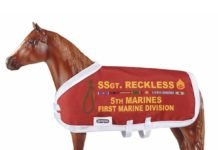Leg wraps are used to protect the lower legs of a horse during shipping, training and exercise, as well as for medical and therapeutic purposes to provide support or cover an injury.
No matter which wrap you are using, the trick to knowing which way to start one is to begin on the inside of the leg and then on the right legs you will wrap clockwise and the left legs you will wrap counterclockwise so that your closures will end on the outside of the leg every time. A properly applied bandage will be tighter on the front of the leg where the bone is and looser on the back part of the leg where the tendons are. You should be able to slip two fingers easily in the top of the bandage once you are finished. Now, let’s learn about the different types of wraps.

The most common wrap is called the Polo wrap or track bandage when used in racing. It is usually made of fleece and can be quite stretchy compared to other bandaging materials and are used primarily for turnout in the pasture, ridden work or longeing. They are simple to use with the wrap beginning just below the knee and going down to the fetlock joint. The most important thing to remember when applying polo bandages is that both left and right legs need to be wrapped with the same amount of pressure or tendon problems could arise. Because of this, it is a good idea to have the same person wrap both legs.
Shipping bandages are used on the lower legs of a horse and, as their name implies, they are used on horses being transported to protect their legs from cuts, bumps, bruises and scrapes while in a trailer. They usually start at the knee or hock and extend all the way down to the heel, providing complete protection of the lower legs. Some people prefer shipping boots because they are easier to apply. Basically, boots slip on and are fastened with loops and hooks. Once again, the pressure of the wrap is critical, so it’s a good idea to have the same person apply all the wraps. The wraps are best for long periods of travel, whereas the shipping boots are good for shorter trips.

The stable bandage or standing bandage/wrap is used on the lower legs just below the knee or hock and runs down to the fetlock joint and is used for various purposes. It can be used to protect the cannon bone, tendons and fetlock joint while a horse is in its stall or trailer. It can also be used to hold a poultice or dressing on a wound or injury. Another use is after hard work or if a horse is kept in the stable for a long period of time, it is used to prevent the legs from filling up with fluid. Because this bandage uses a padding with a wrap over it to keep it in place, it is important to know how to apply this wrap properly without any wrinkles or bunching of the padding beneath the bandage. It’s also important to end the bandage with its clasp on the outside of the leg, otherwise it could catch on the opposite leg or come undone.
Now you know the different types of wraps used to protect your horse’s legs in various situations. Keep an eye out for our article about boots, coming soon!


































